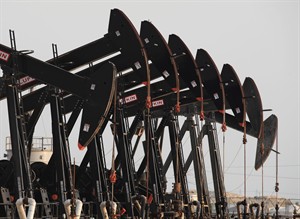
Oil above US$103 a barrel as U.S. supplies fall much more than expected
The price of oil rose Wednesday as the U.S. government reported that American supplies fell more than expected last week.
Benchmark West Texas Intermediate crude for September delivery gained 73 cents to US$103.12 a barrel on the New York Mercantile Exchange. Brent crude for September delivery, a benchmark for international oils, rose 70 cents to US$108.03 on the ICE Futures exchange in London.
The Energy Department reported that U.S. oil supplies fell by four million barrels last week, a sharper decline than the 2.6 million barrels that had been expected by analysts surveyed by Platts, the energy information arm of McGraw-Hill Financial.
On the geopolitical front, U.S. Secretary of State John Kerry arrived in Tel Aviv, seeking to renew a push for a ceasefire after an earlier proposal by Egypt was rejected. Israeli troops battled Hamas militants near a southern Gaza Strip town even as Kerry reported some progress in his efforts.
In other Nymex trading, wholesale gasoline fell two cents to US$2.86 a U.S. gallon (3.79 litres), heating oil rose two cents to US$2.875 a gallon and natural gas fell one cent to US$3.76 per 1,000 cubic feet.
(TSX:ECA), (TSX:IMO), (TSX:SU), (TSX:HSE), (NYSE:BP), (NYSE:COP), (NYSE:XOM), (NYSE:CVX), (TSX:CNQ), (TSX:TLM), (TSX:COS), (TSX:CVE)
Join the Conversation!
Want to share your thoughts, add context, or connect with others in your community?
You must be logged in to post a comment.


















